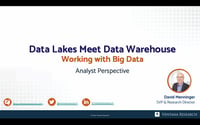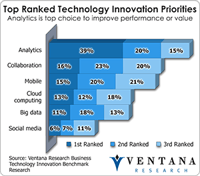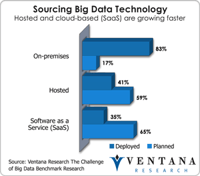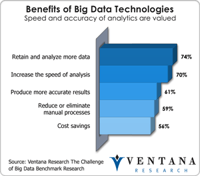In this analyst perspective, Dave Menninger takes a look at data lakes. He explains the term “data lake,” describes common use cases and shares his views on some of the latest market trends. He explores the relationship between data warehouses and data lakes and share some of Ventana Research’s findings on the subject. He also provides an assessment of the risks organizations face in working with data lakes and offers recommendations for maximizing the potential of data.
Read More
Topics:
Big Data,
Data Warehousing,
Analytics,
Business Analytics,
Business Intelligence,
Data Governance,
Data Management,
Data Preparation,
data lakes
This year, Teradata rebranded the Teradata users conference from "Partners" to "Analytics Universe", and there is a reason for it. For decades, Teradata has represented the high end of the analytic database, but new innovations and technologies are adding flexibility to Teradata's licensing as they compete. For the full breakdown of Teradata's Analytics Universe 2018, and my analysis of all the largest announcements, watch my hot take video.
Read More
Topics:
Big Data,
Data Warehousing,
Teradata,
Analytics,
Data Governance,
Data Management,
Data Preparation,
Information Management,
Data,
Digital Technology
Big data was big news in 2012 and probably in 2013 too. The Harvard Business Review talks about it as The Management Revolution. The Wall Street Journal says Meet the New Boss: Big Data, and Big Data is on the Rise, Bringing Big Questions. Given big data’s popularity in the press, you might think that the technology market is only about big data and how companies use the vast and growing amount of data now available to organizations. While this technology can provide a significant opportunity,...
Read More
Topics:
Big Data,
Data Warehousing,
Predictive Analytics,
Social Media,
Harvard Business Review,
Wall Street Journal,
IT Performance,
Operational Performance,
Business Analytics,
Business Collaboration,
Business Intelligence,
Business Performance,
CIO,
Cloud Computing,
Customer & Contact Center,
Financial Performance,
Information Management,
Technology Innovation,
Strata+Hadoop
Kognitio has been serving the analytics and data needs of organizations for more than 20 years with an in-memory analytics platform that meets many of the big-data needs of today’s organizations. Kognitio Analytical Platform provides a unique massively parallel processing (MPP) in-memory database that can rapidly load data and calculate analytics; it is available both in an analytical software appliance and via cloud computing.
Read More
Topics:
Big Data,
Data Warehousing,
Social Media,
alteryx,
IT Performance,
Operational Performance,
Analytics,
Business Analytics,
Business Intelligence,
Business Performance,
Cloud Computing,
Customer & Contact Center,
Hortonworks,
Information Management,
Kognitio,
Strata+Hadoop
At first I thought 1010data just developed a faster data warehouse technology to be used with business intelligence tools. After a recent briefing, however, I learned that it provides much more than a data warehouse; the product is a large-scale analytics server that empowers business analysts to work on big data, conducting for, example, market basket analysis or correlations of customer and product information. The software lets organizations retain and analyze more data and increase the...
Read More
Topics:
Big Data,
Data Warehousing,
Sales Performance,
Predictive,
Operational Performance,
Business Analytics,
Business Intelligence,
Business Performance,
Cloud Computing,
Customer & Contact Center,
Financial Performance,
Information Management
My colleague Mark Smith and I recently chatted with executives of Tidemark, a company in the early stages of providing business analytics for decision-makers. It has a roster of experienced executive talent and solid financial backing. There’s a strategic link with Workday that reflects a common background at the operational and investor levels. As it gets rolling, Tidemark is targeting large and very companies as customers for its cloud-based system for analyzing data. It can automate alerts...
Read More
Topics:
Big Data,
Data Warehousing,
Master Data Management,
Performance Management,
Planning,
Predictive Analytics,
Sales Performance,
GRC,
Budgeting,
Risk Analytics,
Operational Performance,
Analytics,
Business Analytics,
Business Collaboration,
Business Intelligence,
Business Mobility,
Business Performance,
Cloud Computing,
Customer & Contact Center,
Data Governance,
Data Integration,
Financial Performance,
In-Memory Computing,
Information Management,
Mobility,
Workforce Performance,
Risk,
Workday,
Financial Performance Management,
Integrated Business Planning,
Strata+Hadoop
Kalido recently introduced version 9 of its Information Engine product. The company has been around for 10 years but has had difficulty establishing its identity in the information management market. Kalido was perhaps ahead of its time, partly a vendor of data integration, partly master data management and partly data governance. As an example of the positioning challenge, its core product, Information Engine, while not a data integration tool, could in some cases provide sufficient...
Read More
Topics:
Data Quality,
Data Warehousing,
Master Data Management,
Data Governance,
Data Integration,
Governance, Risk & Compliance (GRC),
Information Applications,
Information Management,
Kalido
Read More
Topics:
Big Data,
Data Warehousing,
Predictive Analytics,
Sales Performance,
Supply Chain Performance,
Teradata,
Operational Performance,
Business Analytics,
Business Intelligence,
Business Performance,
Customer & Contact Center,
Financial Performance,
Workforce Performance,
Digital Technology
Read More
Topics:
Big Data,
Data Warehousing,
Predictive Analytics,
Sales Performance,
Social Media,
Supply Chain Performance,
Operational Performance,
Business Analytics,
Business Intelligence,
Business Performance,
Customer & Contact Center,
Financial Performance,
Karmasphere,
Workforce Performance,
Strata+Hadoop
Read More
Topics:
Data Warehousing,
Microsoft,
RDBMS,
SAS,
Teradata,
IT Performance,
Business Intelligence,
Cloud Computing,
Data Management,
HP,
IBM,
Information Management,
Oracle















